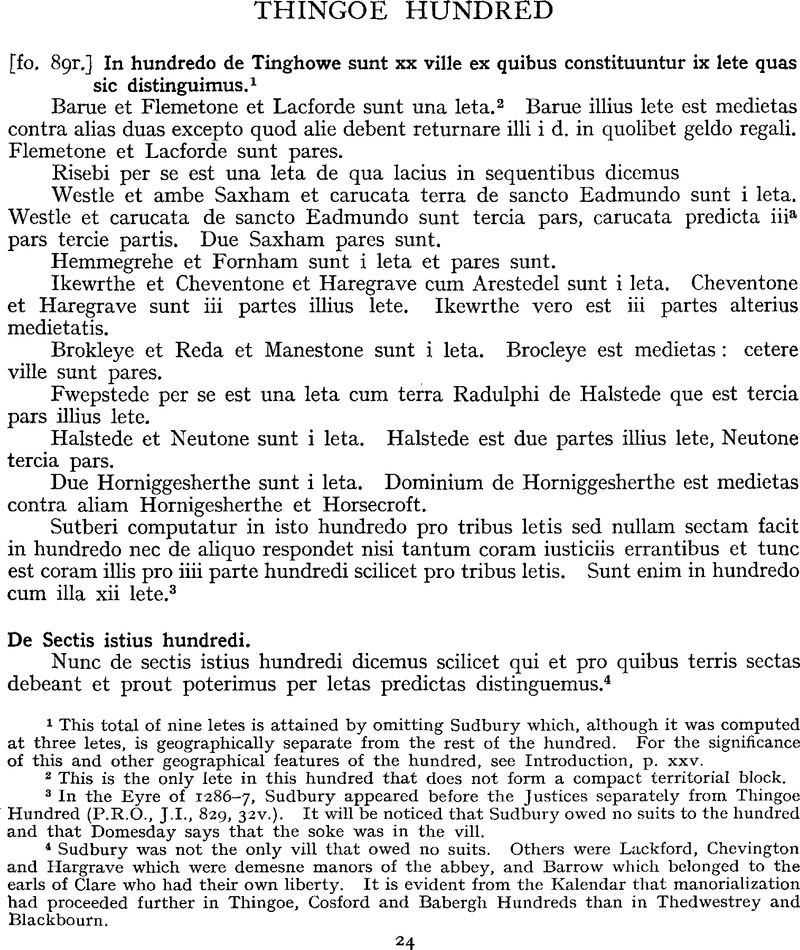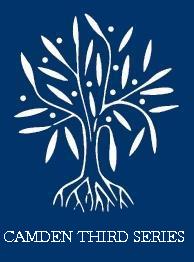Article contents
Thingoe Hundred
Published online by Cambridge University Press: 24 December 2009
Abstract

- Type
- The Kalendar of Abbot Samson
- Information
- Copyright
- Copyright © Royal Historical Society 1954
References
page 24 note 1 This total of nine letes is attained by omitting Sudbury which, although it was computed at three letes, is geographically separate from the rest of the hundred. For the significance of this and other geographical features of the hundred, see Introduction, p. xxv.
page 24 note 2 This is the only lete in this hundred that does not form a compact territorial block.
page 24 note 3 In the Eyre of 1286–7, Sudbury appeared before the Justices separately from Thingoe Hundred (P.R.O., J.I., 829, 32V.). It will be noticed that Sudbury owed no suits to the hundred and that Domesday says that the soke was in the vill.
page 24 note 4 Sudbury was not the only vill that owed no suits. Others were Lackford, Chevington and Hargrave which were demesne manors of the abbey, and Barrow which belonged to the earls of Clare who had their own liberty. It is evident from the Kalendar that manorialization had proceeded further in Thingoe, Cosford and Babergh Hundreds than in Thedwestrey and Blackbourn.
page 25 note 1 It is evident from this that the abbey's manor of Nowton had withdrawn itself from the hundred's jurisdiction. The socage land consisted only of 30 ware acres (infra, p. 30). In 1086 there were 60 ware acres of socage land, but the manor was assessed at four carucates (D.B., ii. 357).
page 25 note 2 This is the majority of the men.
page 25 note 3 E.g. infra, p. 26.
page 25 note 4 These seem to be de alto socagio, e.g. infra, p. 27. But contrast infra, pp. 29–30.
page 26 note 1 In 1086 there was one carucate of socage land (D.B., ii. 357b). The other half-carucate was presumably that of William (of Ickworth ?), which is noted below as being in Flempton but whose hidage went to Ickworth. In 1086 the sokemen owed services in the neighbouring vills of Risby, Lackford and Hengrave.
page 26 note 2 Perhaps a mistake for ‘ domino de Ikewrthe ’. ‘ Dompnus Willelmus ’ held Ickworth of the abbot, infra, p. 28.
page 26 note 3 In 1086 there were 8 acres of socage land (D.B., ii. 357).
page 26 note 4 I.e. the earl of Clare. Barrow was terra regis in 1086 (D.B., ii. 289b).
page 26 note 5 In 1086 there were 1½ carucates of socage land (D.B., ii. 356b).
page 26 note 6 William of Risby (alias Willelmus miles, infra, pp. 32, 33) was the son of Robert of Saxham and had once befriended Abbot Samson (Jocelin, p. 44). He was dead by 1197. A charter in the Cellarer's Register (P.R.O., D. of L. 42. 5, fo. 27V.) locates ten acres of William's land in the field (campo) stretching towards Cavenham, and they apparently formed a single block of land.
page 26 note 7 This sum paid to Ralph is presumably rent or census. The men may have been commended to him.
page 26 note 8 Two carucates which T.R.E. had been held by Ulmar a thegn of Stigand and had subsequently passed to Roger of Poitou.
page 26 note 9 D.B., ii. 356b. Norman held one freeman with ½ carucate, from the abbot.
page 26 note 10 In 1086 there were 11 freemen with 2 carucates (D.B., ii. 358b).
page 27 note 1 In 1086 Richard FitzGilbert (de Clare) held three men with 80 acres who had been under Wisgar; also ⅔ mill and one freeman with ½ carucate who was under St. Edmund by commendation and soke (D.B., ii. 391).
page 27 note 2 See Jocelin, pp. 117 ff., and Charters 28 and 31.
page 27 note 3 Cf. Oxford, Bodleian MS. Charters, Suffolk a.1, no. 15, which records the sale by Richard son of Anchis to Thomas the goldsmith of all the service which William son of Aelric owed him, ‘ viz three shillings which he owed me yearly from the whole fee which he held from me in the field (campo) towards Fornham which is called Clipeshoghe and in the field which abuts onto the road leading to Fornham, which fee is counted as ten acres of land, whether it contains more or less ’. The sale was for three silver marks and a gold mark. It is impossible to tell with certainty whether the sale refers to this particular land in the Kalendar or not. The date of the sale is c. 1200. William son of Aelric is mentioned as holding additional land above.
page 27 note 4 As in 1086 (D.B., ii. 357).
page 27 note 5 Gilbert FitzRalph owed three knights in all; one in Whelnetham and Hepworth; one in Reydon and Gissing; and one in Saxham (Jocelin, p. 120). He seems to have inherited the land that had been Fulcher's in 1086 (D.B., ii. 357b and D.C.D., p. 17).
page 27 note 6 His land was probably held by Albert in 1086 (D.B., ii. 357b).
page 28 note 1 Similarly there were 60 acres of socage land in 1086 (D.B., ii. 357b).
page 28 note 2 Presumably William son of Leo to whom (as to his father) the manor of Hengrave had been granted for an annual rent of 110s. (D.C.D., nos. 147, 124).
page 28 note 3 There were 30 acres of socage land in 1086 (D.B., ii. 357b).
page 28 note 4 Master Roger of Walsingham. See Charter 56.
page 28 note 5 Chevington was given to the abbey in the reign of William I (D.C.D., p. 4). Hargrave was a more recent addition. In 1086 it was held by William de Watteville (D.B., ii. 43.5).
page 28 note 6 William of Ickworth. For the history of this fief, see Gage, History of Suffolk, p. 275.
page 28 note 7 The three carucates are made up of (1) the two carucates which Theobald the clerk and Robert held from the abbey in 1086 (D.B., ii. 358, and D.C.D., p. 18); (2) 60 acres held by Roger of Poitou in chief (D.B., ii. 349b); this is the half-carucate now held by Nicholas of Gedding from the honor of Lancaster; (3) half a carucate which Richard held from Robert son of Corbuzzo (D.B., ii. 425b).
page 29 note 1 Cf. D.B., ii. 358, 381b, 391b, 401.
page 29 note 2 See p. 27, n. 5 supra. Roger Beauchamp was of the house of Stephen Beauchamp, sheriff of Essex in 1168–9 (Gage, History of Suffolk, p. 367).
page 29 note 3 Ralph son of Brian de Rede held additional lands in Rede from Abbot Samson for an annual rent of 5s. to the hall at Horringer. See Charter 71, dated 1199, confirming them to him on his father's death.
page 29 note 4 Similarly the monks of Ely held 20 acres in demesne in 1086 (D.B., ii. 381b).
page 29 note 5 In 1086 there were two sokemen with 20 acres each, held by St. Edmund's and Suane of Essex respectively (D.B., ii. 358, 401), and also a freeman with ½ carucate held by Richard FitzGilbert (Clare) (D.B., ii. 391b). It would seem as if the tenements had not changed.
page 29 note 6 So also in 1086 there were 30 acres of socage land (D.B., ii. 356b). Then the socager could not sell his land without licence. The additional six freemen with 150 acres recorded by Domesday are placed in Hawstead by Abbot Baldwin's ‘ Feudal Book ’ (D.C.D., p. 24). The two vills are adjacent.
page 29 note 7 This suggests that the survey of the letes (supra, p. 24) originally came, not at the beginning, but at the end, of the survey.
page 29 note 8 See Charter 62. This land is carefully distinguished from the others which Solomon of Muckinges held in Whepstead by the fact that it ‘ defends itself towards the hundred’.
page 29 note 9 In 1086 St. Edmund held 7 carucates and 20 acres here, of which 4 carucates were held by 28 freemen (D.B., ii. 358). Richard FitzGilbert (Clare) also held two freemen with 15 acres (D.B., ii. 391b).
page 29 note 10 See Charter 73, which records that the hidage from this and other socage lands of Thomas Noel was paid to the reeve of Thingoe Hundred.
page 30 note 1 In fact he had to pay 20s. at Easter and 20s. at Michaelmas. The land was granted to him before 1190 (Charter 72).
page 30 note 2 Cf. Jocelin, p. 121. Ralph had died by 1199 and had been succeeded by his son Robert (Charter 69).
page 30 note 3 In 1086 there was ½ carucate of socage land (D.B., ii. 357).
page 30 note 4 In 1086 there were 15 sokemen with one carucate of socage land in Horningsheath. This carucate was presumably spread over Great and Little Horningsheath and Horsecroft. In the Kalendar the total amount of socage land in these three places has been reduced to 60 acres.
page 30 note 5 I.e. Richard Sumerlede holds about three acres of another piece of socage land which is not counted in the vill's fifteen acres of socage land.
page 30 note 6 William son of Geoffrey also held land in Rede and a wood called ‘ Littlehei ’ from the manor of Horningsheath (Charter 70).
- 4
- Cited by


